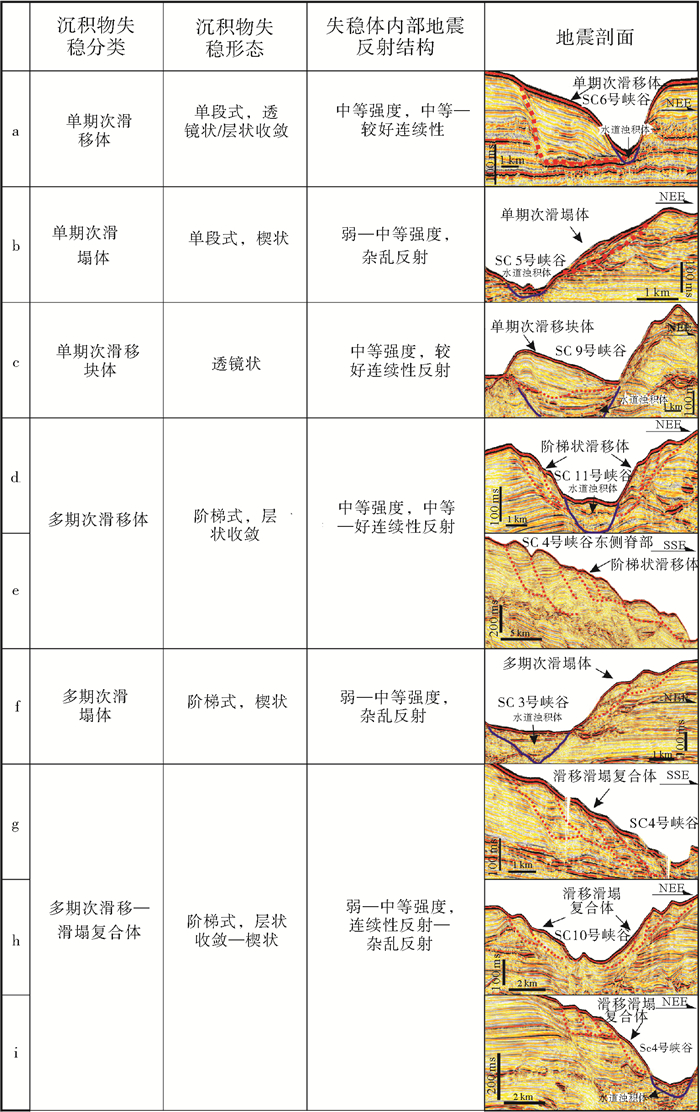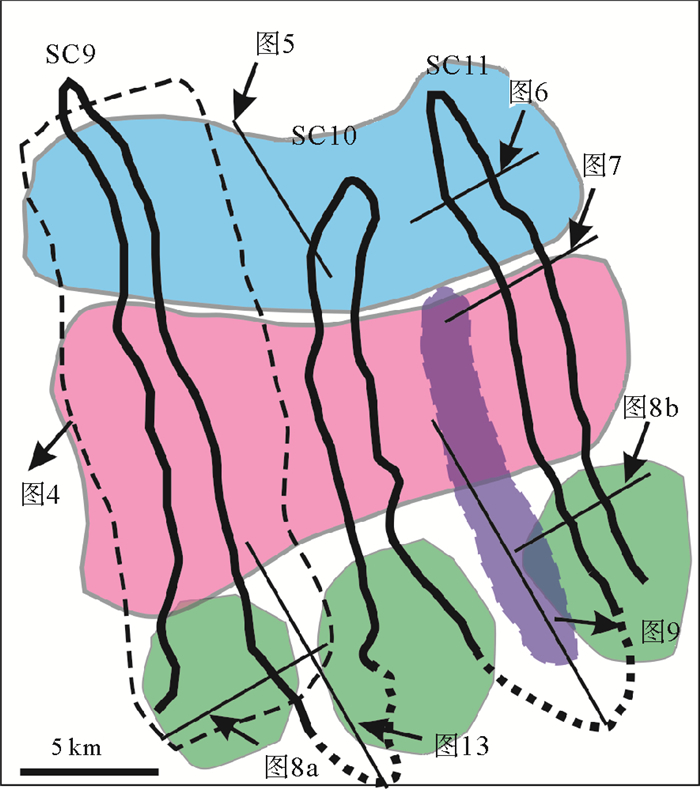SEDIMENT FAILURES IN THE SHENHU AREA, NORTHERN CONTINENTAL SLOPE OF THE SOUTH CHINA SEA
-
摘要:
利用广州海洋地质调查局采集的2D和准3D地震资料,从整体形态、期次性和内部结构等方面对南海北部陆坡神狐海域内广泛发育的沉积物失稳进行了类型划分和特征描述,并将沉积物失稳的分布特征和陆坡限制型海底峡谷群的分段性进行耦合关联,进而分析沉积物失稳的空间变化规律。研究结果显示,沉积物失稳可以划分为两种类型:第一种类型位于峡谷群的下游段,几乎不受峡谷群地貌的影响,表现为多期次、内部连续和自北向南的块体运动方式,主要以“残留”的形式位于峡谷群脊部;另一种类型主要表现为沿峡谷群脊部向谷底的块体运动方式,受到峡谷群地形起伏的影响,在峡谷群头部,主要为多期次滑移体,中游段变形强度最大,滑塌体是主要的类型,而在下游段-嘴部,表现为滑移块体。第四纪以来,源自北部珠江水系充足的沉积物供给和自北向南较陡的海底地形,是沉积物失稳发育的关键控制因素;陆坡限制型海底峡谷群可能造成了沉积物的再次变形作用,使得沉积物失稳的空间变化规律与峡谷群分段性具有对应关系。此外,神狐海域含气流体的垂向运移以及水合物矿体的存在,也是研究区内沉积物失稳的重要控制因素。
-
关键词:
- 沉积物失稳 /
- 滑移 /
- 滑塌 /
- 陆坡限制型海底峡谷群 /
- 神狐海域
Abstract:With the seismic data acquired by the Guangzhou Marine Geological Survey, we studied the types and characteristics of the frequently developed sediments failures in the Shenhu area of the northern South China Sea. The distribution pattern of sediment failures is adopted to reveal the relationship between slope-confined submarine canyons and sediment failures. The sediments failures in the study area can be grouped to two types. The first type, which is mainly located at the ridges in the lower reach of a canyon and hardly affected by seafloor geomorphology, is characterized by multiple continuous wavy reflectors in a pattern of southwards mass movement. The second type is mainly the products of the mass movement from the ridge to the bottom of a canyon, and is obviously affected by the topography of the canyons. At the head of a canyon, sediment failures always occur as slides with continuous reflectors. And in the middle reach there is intensive deformation and dominated by slumps. From the lower reach to the canyon mouth, however sliding/slumping blocks dominate. Since Quaternary, Great amount of sediment charges come from the Pearl River system towards the north. With the help of steep seafloor topography, the activity of sediment failures is accelerated. Sediment re-deformation may widely occur in submarine canyons. In addition, the vertical migration of gas-bearing fluids coming from gas hydrate is also an important factor for sediment instabilities in the study area.
-
Key words:
- sediment instability /
- slide /
- slump /
- slope-confined submarine canyons /
- Shenhu Area
-

-
[1] Mills P C. Genesis and diagnostic value of soft-sediment deformation structures-A review[J]. Sedimentary Geology, 1983, 35(2): 83-104. doi: 10.1016/0037-0738(83)90046-5
[2] Hampton M A, Lee H J, Locat J. Submarine landslides[J]. Reviews of Geophysics, 1996, 34(1): 33-59. http://d.old.wanfangdata.com.cn/Periodical/sdlxyjyjz-e201704002
[3] McAdoo B G, Pratson L F, Orange D L. Submarine landslide geomorphology, US continental slope[J]. Marine Geology, 2000, 169(1-2): 103-136. doi: 10.1016/S0025-3227(00)00050-5
[4] Canals M, Lastras G, Urgeles R, et al. Slope failure dynamics and impacts from seafloor and shallow sub-seafloor geophysical data: case studies from the COSTA project[J]. Marine Geology, 2004, 213(1-4): 9-72. doi: 10.1016/j.margeo.2004.10.001
[5] Moscardelli L, Wood L. New classification system for mass transport complexes in offshore Trinidad[J]. Basin Research, 2008, 20(1): 73-98. doi: 10.1111/j.1365-2117.2007.00340.x
[6] Bull S, Cartwright J, Huuse M. A review of kinematic indicators from mass-transport complexes using 3D seismic data[J]. Marine and Petroleum Geology, 2009, 26(7): 1132-1151. doi: 10.1016/j.marpetgeo.2008.09.011
[7] Bryn P, Berg K, Forsberg C F, et al. Explaining the storegga slide[J]. Marine and Petroleum Geology, 2005, 22(1-2): 11-19. doi: 10.1016/j.marpetgeo.2004.12.003
[8] Hsu S K, Tsai C H, Ku C Y, et al. Flow of turbidity currents as evidenced by failure of submarine telecommunication cables[M]//Chiocci F L, Ridenti D, Casalbore D, et al. Extended Abstracts of the International Conference on Seafloor Mapping for Geohazard Assessment. Rendiconti Online della Società Geologica Italiana, 2009: 167-171.
[9] Van Loon A J, Brodzikowski K. Problems and progress in the research on soft-sediment deformations[J]. Sedimentary Geology, 1987, 50(1-3): 167-193. doi: 10.1016/0037-0738(87)90032-7
[10] Locat J, Lee H J. Submarine landslides: advances and challenges[J]. Canadian Geotechnical Journal, 2002, 39(1): 193-212. doi: 10.1139/t01-089
[11] Sultan N, Cochonat P, Canals M, et al. Triggering mechanisms of slope instability processes and sediment failures on continental margins: a geotechnical approach[J]. Marine Geology, 2004, 213(1-4): 291-321. doi: 10.1016/j.margeo.2004.10.011
[12] Li X S, Zhou Q J, Su T Y, et al. Slope-confined submarine canyons in the Baiyun deep-water area, northern South China Sea: variation in their modern morphology[J]. Marine Geophysical Research, 2016, 37(2): 95-112. doi: 10.1007/s11001-016-9269-0
[13] 刘杰, 苏明, 乔少华, 等.珠江口盆地白云凹陷陆坡限制型海底峡谷群成因机制探讨[J].沉积学报, 2016, 34(5): 940-950. http://d.old.wanfangdata.com.cn/Periodical/cjxb201605013
LIU Jie, SU Ming, QIAO Shaohua, et al. Forming mechanism of the slope-confined submarine canyons in Baiyun Sag, Pearl River Mouth Basin[J]. Acta Sedimentologica Sinica, 2016, 34(5): 940-950. http://d.old.wanfangdata.com.cn/Periodical/cjxb201605013
[14] He Y, Zhong G F, Wang L L, et al. Characteristics and occurrence of submarine canyon-associated landslides in the middle of the northern continental slope, South China Sea[J]. Marine and Petroleum Geology, 2014, 57: 546-560. doi: 10.1016/j.marpetgeo.2014.07.003
[15] Chen D X, Wang X J, Völker D, et al. Three dimensional seismic studies of deep-water hazard-related features on the northern slope of South China Sea[J]. Marine and Petroleum Geology, 2016, 77: 1125-1139. doi: 10.1016/j.marpetgeo.2016.08.012
[16] Qiao S H, Su M, Kuang Z G, et al. Canyon-related undulation structures in the Shenhu area, northern South China Sea[J]. Marine Geophysical Research, 2015, 36(2-3): 243-252. doi: 10.1007/s11001-015-9252-1
[17] Wu N Y, Zhang H Q, Yang S X, et al. Gas hydrate system of Shenhu Area, northern South China Sea: geochemical results[J]. Journal of Geological Research, 2011, 2011: 370298.
[18] Ru K, Pigott J D. Episodic rifting and subsidence in the South China Sea[J]. AAPG Bulletin, 1986, 70(9): 1136-1155.
[19] 于兴河, 梁金强, 方竞男, 等.珠江口盆地深水区晚中新世以来构造沉降与似海底反射(BSR)分布的关系[J].古地理学报, 2012, 14(6): 787-800. http://d.old.wanfangdata.com.cn/Periodical/gdlxb201206010
YU Xinghe, LIANG Jinqiang, FANG Jingnan, et al. Tectonic subsidence characteristics and its relationship to BSR distribution in deep water area of Pearl River Mouth Basin since the Late Miocene[J]. Journal of Palaeogeography, 2012, 14(6): 787-800. http://d.old.wanfangdata.com.cn/Periodical/gdlxb201206010
[20] 吴时国, 董冬冬, 杨胜雄, 等.南海北部陆坡细粒沉积物天然气水合物系统的形成模式初探[J].地球物理学报, 2009, 52(7): 1849-1857. doi: 10.3969/j.issn.0001-5733.2009.07.019
WU Shiguo, DONG Dongdong, YANG Shengxiong, et al. Genetic model of the hydrate system in the fine grain sediments in the northern continental slope of South China Sea[J]. Chinese Journal of Geophysics, 2009, 52(7): 1849-1857. doi: 10.3969/j.issn.0001-5733.2009.07.019
[21] Lüdmann T, Wong H K, Wang P X. Plio-Quaternary sedimentation processes and neotectonics of the northern continental margin of the South China Sea[J]. Marine Geology, 2001, 172(3-4): 331-358. doi: 10.1016/S0025-3227(00)00129-8
[22] Pang X, Chen C M, Peng D J, et al. Sequence stratigraphy of deep-water fan system of Pearl River, South China Sea[J]. Earth Science Frontiers, 2007, 14(1): 220-229. doi: 10.1016/S1872-5791(07)60010-4
[23] 苏明, 沙志彬, 乔少华, 等.南海北部神狐海域天然气水合物钻探区第四纪以来的沉积演化特征[J].地球物理学报, 2015, 58(8): 2975-2985. http://www.wanfangdata.com.cn/details/detail.do?_type=perio&id=dqwlxb201508030
SU Ming, SHA Zhibin, QIAO Shaohua, et al. Sedimentary evolution since Quaternary in the Shenhu hydrate drilling area, northern South China Sea[J]. Chinese Journal of Geophysics, 2015, 58(8): 2975-2985. http://www.wanfangdata.com.cn/details/detail.do?_type=perio&id=dqwlxb201508030
[24] Wang X J, Collett T S, Lee M W, et al. Geological controls on the occurrence of gas hydrate from core, downhole log, and seismic data in the Shenhu area, South China Sea[J]. Marine Geology, 2014, 357: 272-292. doi: 10.1016/j.margeo.2014.09.040
[25] Zhang P Z, Molnar P, Downs W R. Increased sedimentation rates and grain sizes 2-4 Myr ago due to the influence of climate change on erosion rates[J]. Nature, 2001, 410(6831): 891-897. doi: 10.1038/35073504
[26] Huang W, Wang P X. Sediment mass and distribution in the South China Sea since the Oligocene[J]. Science in China Series D: Earth Sciences, 2006, 49(11): 1147-1155. doi: 10.1007/s11430-006-2019-4
[27] Huang W, Wang P X. Statistics of sediment mass in the South China Sea: method and result[J]. Frontiers of Earth Science in China, 2007, 1(1): 88-96. doi: 10.1007/s11707-007-0012-7
[28] Nakajima T, Kakuwa Y, Yasudomi Y, et al. Formation of pockmarks and submarine canyons associated with dissociation of gas hydrates on the Joetsu Knoll, eastern margin of the Sea of Japan[J]. Journal of Asian Earth Sciences, 2014, 90: 228-242. doi: 10.1016/j.jseaes.2013.10.011
[29] Wu N Y, Zhang H Q, Yang S X, et al. Preliminary discussion on natural gas hydrate reservoir system of Shenhu area, north slope of south china sea[C]//Proceedings of the 6th International Conference on Gas Hydrates (ICGH 2008). Vancouver, British Columbia: CANADA, 2008.
[30] Yang S X, Zhang H Q, Wu N Y, et al. High concentration hydrate in disseminated forms obtained in Shenhu area, North Slope of South China Sea[C]//Proceedings of the 6th International Conference on Gas Hydrates (ICGH 2008). Vancouver, British Columbia: CANADA, 2008.
[31] Yang S X, Zhang M, Liang J Q, et al. Preliminary results of China's third Gas hydrate drilling expedition: a Critical step from discovery to development in the South China Sea[J]. Fire in the Ice, 2015, 15(2): 1-21.
[32] 郭依群, 杨胜雄, 梁金强, 等.南海北部神狐海域高饱和度天然气水合物分布特征[J].地学前缘, 2017, 24(4): 24-31. http://d.old.wanfangdata.com.cn/Periodical/dxqy201704003
GUO Yiqun, YANG Shengxiong, LIANG Jinqiang, et al. Characteristics of high gas hydrate distribution in the Shenhu area on the northern slope of the South China Sea[J]. Earth Science Frontiers, 2017, 24(4): 24-31. http://d.old.wanfangdata.com.cn/Periodical/dxqy201704003
[33] Su M, Sha Z B, Zhang C M, et al. Types, Characteristics and significances of migrating pathways of gas-bearing fluids in the Shenhu Area, northern continental slope of the South China Sea[J]. Acta Geologica Sinica, 2017, 91(1): 219-231. doi: 10.1111/1755-6724.13073
-




 下载:
下载:











